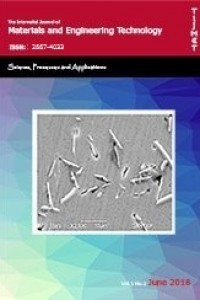INVESTIGATION OF THE HUB DIAMETER EFFECT ON PROPELLER THRUST
INVESTIGATION OF THE HUB DIAMETER EFFECT ON PROPELLER THRUST
___
- Ismail, K. A., & Rosolen, C. V. (2019). Effects of the airfoil section, the chord and pitch distributions on the aerodynamic performance of the propeller. Journal of the Brazilian Society of Mechanical Sciences and Engineering, 41(3), 1-19.Stumm, W., and Melia, C.R.O. Stoichiometry of Coagulation. Jour. AWWA, 1968, 60(5):514-539.
- Haidar, M. D. F., Moelyadi, M. A., & Hartono, F. (2019, October). Design and Performance Analysis of Low Reynolds Number Propeller using Analytical Methods by Varying Blades Alpha Design. In IOP Conference Series: Materials Science and Engineering (Vol. 645, No. 1, p. 012021). IOP Publishing.
- Benini, E. (2004). Significance of blade element theory in performance prediction of marine propellers. Ocean engineering, 31(8-9), 957-974.
- Kutty, H. A., & Rajendran, P. (2017). 3D CFD simulation and experimental validation of small APC slow flyer propeller blade. Aerospace, 4(1), 10.
- Kumar, A., Krishna, G. L., & Subramanian, V. A. (2019). Design and analysis of a carbon composite propeller for podded propulsion. In Proceedings of the Fourth International Conference in Ocean Engineering (ICOE2018) (pp. 203-215). Springer, Singapore.
- Akturk, A., & Camci, C. (2011). A computational and experimental analysis of a ducted fan used in VTOL UAV systems. Department of Aerospace Engineering, Pennsylvania University, USA.
- Doğru, M. H., Güzelbey, İ. H., & Göv, İ. (2016). Ducted Fan Effect on the Elevation of a Concept Helicopter When the Ducted Faintail Is Located in a Ground Effect Region. Journal of Aerospace Engineering, 29(1), 04015030.
- İbrahim, G. Ö. V. Rotor Spacing and Blade Number Effect on the Thrust, Torque and Power of a Coaxial Rotor. El-Cezeri Journal of Science and Engineering, 7(2), 487-502.
- Brandt, J., & Selig, M. (2011, January). Propeller performance data at low reynolds numbers. In 49th AIAA Aerospace Sciences Meeting including the New Horizons Forum and Aerospace Exposition (p. 1255).
- Islam, M. F., & Jahra, F. (2019). IMPROVING ACCURACY AND EFFICIENCY OF CFD PREDICTIONS OF PROPELLER OPEN WATER PERFORMANCE. Journal of Naval Architecture & Marine Engineering, 16(1).
- Yayın Aralığı: Yılda 2 Sayı
- Başlangıç: 2018
- Yayıncı: Necip Fazıl YILMAZ
Nasır MOHAMMED TAHIR, Adamu Umar ALHAJİ, Ibrahim ABDULLAHİ
EFFECT OF PROPELLERS NUMBERS AND HORIZONTAL DISTANCE IN DESIGN OF VTOL
Mustafa VARKİ, Eyüp YETER, Mehmet Hanifi DOĞRU
Doğan ACAR, Salim Levent AKTUĞ, Kemal KORKMAZ, Salih DURDU, Ömer Necati CORA
EFFECT OF DIFFERENT AMOUNTS OF CARBON FIBER ADDITIVE ABS ON THERMAL DISTORTION AND COOLING TIME
Ömer EYERCİOĞLU, Engin TEK, Mehmet ALADAĞ, Gülağa TAŞ
Mahmut Furkan KALKAN, Murat ARTAN, Hasan Mithat DELİBAŞ, Abdulcabbar YAVUZ, Necip Fazıl YILMAZ
ANALYSIS OF MECHANICAL BEHAVIOR OF TERMOPLASTIC COMPOSITES
Ali Taner KUZU, Elifnur KÖSEMEN, Aysu Hande YÜCEL, Mustafa BAKKAL
INVESTIGATION OF THE HUB DIAMETER EFFECT ON PROPELLER THRUST
Enes COŞKUN, Mehmet Hanifi DOĞRU
Oğuzcan GÜZELİPEK, Tuğrul SOYUSİNMEZ, Furkan ÇETİN
ANALYSIS OF WIND TURBINE BLADE PITCH ANGLE CONTROL WITH FUZZY LOGIC
